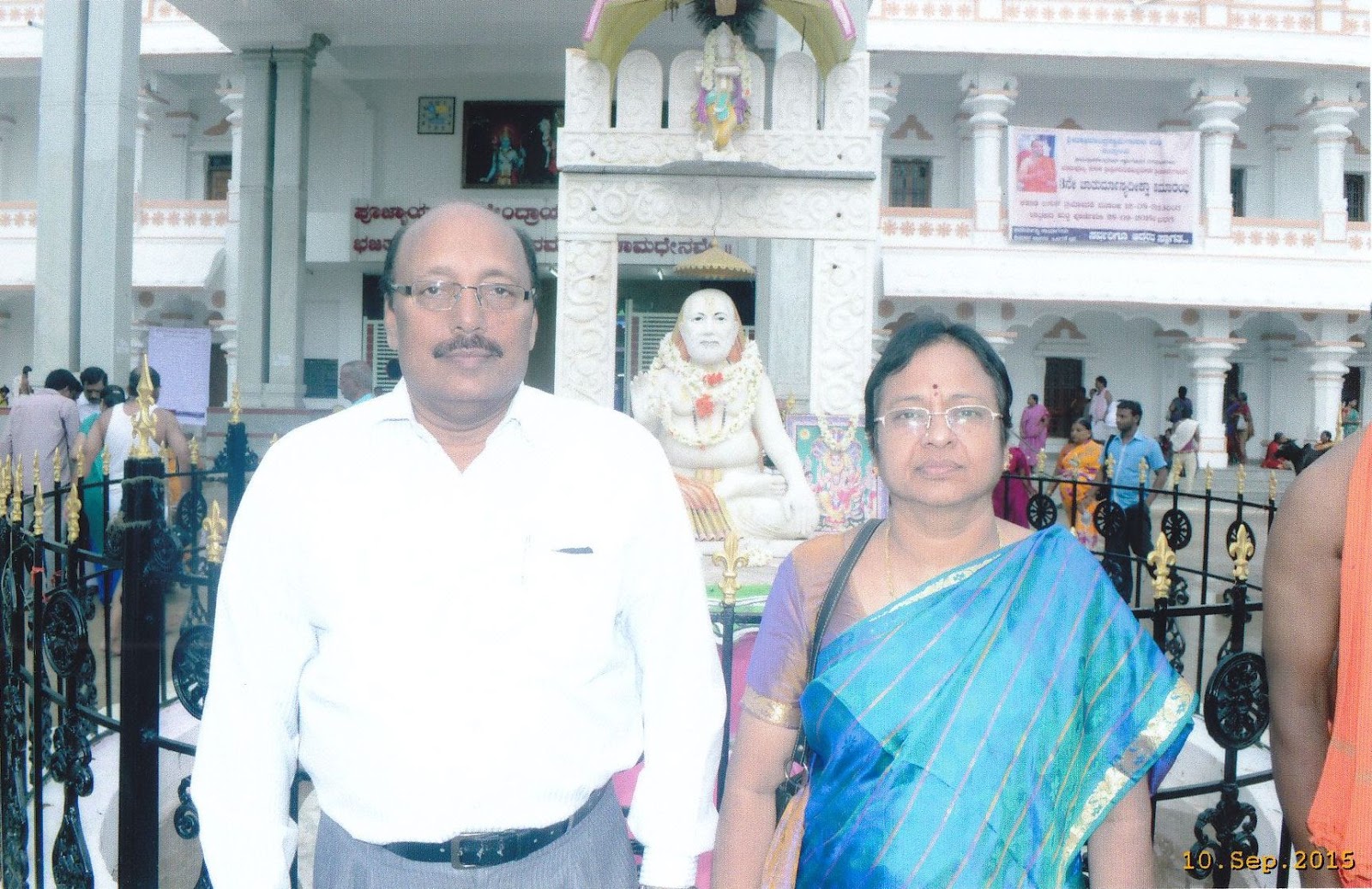These photographs are from our recent visit to
Brindavanam at Mantralayam, on 9th and 10th of September 2015. This article as
usual is for friends and family to read, and more importantly for those who
have not heard of this popular place of pilgrimage in South India, located at
Mantralayam of Kurnool District in Andhra Pradesh. Brindavanam is the place
where Sri Raghavendra Swamy (1595-1671) attained Jeeva Samadhi. Sri Raghavendra
Swamy was a renowned Hindu saint, philosopher, Guru, musician, Veena player and
a proponent of Dvaita philosophy established by Sri Madhavacharya. We were
there to seek his blessings at his Brindavanam. Every day pilgrims visit this
place in very large numbers from all over, especially South India, offer
prayers and are blessed with his miraculous benevolence.
Sri Raghavendra Swamy was born as Venkatanatha
to Kannada Brahmin parents, Sri Thimmanna Bhattu and Gopikamba in 1595, in the
town of Bhuvanagiri in Tamil Nadu. He was named after Lord Venkateshwara Swamy
of Tirumala and was fondly called as Venkatanatha and Venkanna Bhattu in his
childhood and also as Venkatacharya. He was the third and youngest child of his
parents, after a brother and sister named Gururajacharya and Venkatamba.
Thimmanna Bhattu was a famous scholar proficient in the Vedas and Sastras and
an accomplished player of the Veena. When Venkatanatha was five years old and
began going to school, his father Thimmanna Bhattu took ill and expired. Then
the responsibility of educating Venkatanatha fell on his elder brother Gururaja
who found it very difficult to maintain his family. When Venkatanatha was eight
years old Gururaja performed his Upanayanam with the help of donations from his
community and sent him to Madurai to his brother-in-law, Lakshminarasimhacharya
for imparting further education. Lakshminarasimhacharya felt it not only easy
but a pleasure to teach his new ward as the latter was quick to learn. In a
short time, Venkatanatha acquired mastery over the Vedas, the six Sastras and
the eighteen Puranas and became unrivalled in scholarship.
After Sri Venkatanatha returned from Madurai in
1614, he was married to Saraswathi Bai and they were blessed with a son
Lakshminarayanacharya in the same year. And then Venkatanatha and his family
shifted to Kumbakonam, where he studied Dwaitha Vedanta, grammar and literary
works under his Guru, Sri Sudheendra Theertha. Venkatanatha was already well
versed in Bhashyas and consistently prevailed over renowned and reputed
scholars, irrespective of the complexity of the debates. He was an ardent
devotee of Sri Rama and Sri Hanuman. He spent a large part of his time in
prayers and teaching Sanskrit and the ancient Vedic texts to children. He never
demanded any money for his services.
While Venkatanatha’s life was spent in the
worship of God and service to humanity, his spiritual Guru, Sri Sudheendra
Theertharu was looking for a successor to his Mutt. Sri Sudheendra Theertharu
had a dream where the Lord indicated that Venkatanatha would be the right
person to succeed him as the pontiff. Sri Venkatanatha had to become a Sanyasi
for this. He initially refused; due to his responsibility towards his young
wife and son but was soon blessed by the Goddess of Learning, where she in a
dream indicated that he was to seek salvation as a Sanyasi. Sri Venkatanatha
treated this as an omen and changed his mind. The Sanyasa ordination took place
in 1621 at Tanjore and he adopted the name of Raghavendra Theertha. His wife
Smt. Saraswathi died soon afterwards and his son became his disciple.
Sri Raghavendra Theertha succeeded his Guru Sri
Sudheendra Theertha as the head of Sri Mutt and served from 1621 to 1671. He
traveled extensively all over South India expounding Madhavacharya’s Dvaita
philosophy. He became a very popular Guru and there are a number of miracles
and tales of his benevolence and his blessings from that period.
One such tale of miracle is of an illiterate
sheep rancher, a devotee of Sri Raghavendra Swamy coming across the Nawab
(King) of Adoni, Nawab Siddi Masud Khan and then miraculously becoming Diwaan
of Adoni. Long after this incident Sri Raghavendra Swamy happened to meet the
Nawab of Adoni and as a result of their interactions the king was impressed and
became an ardent devotee of Sri Raghavendra Swamy. Out of respect and
admiration the Nawab offered to give Swamiji any amount of land and wealth.
Swamiji refused any such gifts for his personal gains; he asked for some land
in Manchale – present day Mantralayam, on the banks of River Tungabhadra, to be
handed over to his Mutt. Thus the Mutt moved to Mantralayam, from where Sri
Raghavendra Swamy continued his spiritual journey. He performed penance at a
place called Panchamukhi, near Mantralayam where he had darshan of Lord Hanuman
in the form of Sri Panchamukha Hanuman – five headed Hanuman. At Mantralayam
Sri Raghavendra Swamy encouraged Annadhanam (serving of food for free) to all
devotees, which is followed to this day, since centuries!
In 1671 at the age of 76 years he decided to go
into Jeeva Samadhi at Mantralayam. He had given an indication of this intention
to his devotees much earlier. He waited to choose the exact time, which
happened to be seconed day (Dwadashi) of Sravana Masam, Krishna Paksham in
1671. He offered prayers to Manchalamma, the presiding deity of Manchale –
Mantralayam and sought her permission for his Jeeva Samadhi – Brindavana, and
then at the Mutt he gave a soul-stirring speech to hundreds of devotees who had
gathered to witness the event and he went into Samadhi.
For more Life details of Sri Raghavendra Swamy,
his innumerable miracles in brief, during his lifetime and there afterwards,
Brindavanam rituals and timings and of how to reach Mantralayam you may click
on the following link:




























No comments:
Post a Comment